
Kirby is the titular character and protagonist of the Kirby series of video games owned by Nintendo and HAL Laboratory. He first appeared in Kirby's Dream Land (1992), a platform game for the Game Boy. Since then, Kirby has appeared in over 50 games, ranging from action platformers to puzzle, racing, and even pinball, and has been featured as a playable character in every installment of the Super Smash Bros. series (1999–present). He has also starred in his own anime and manga series. Since 1999, he has been voiced by Makiko Ohmoto.

Kirby: Canvas Curse, known in Europe as Kirby: Power Paintbrush, is a platforming video game developed by HAL Laboratory, published by Nintendo for the Nintendo DS and released in 2005 and is the first Kirby game to be released for the system. While Kirby: Canvas Curse is a platformer, it does not play like a traditional Kirby video game, as it solely requires the use of the stylus. A Wii U sequel, Kirby and the Rainbow Curse, was released on January 22, 2015 in Japan, February 20, 2015 in North America, May 8, 2015 in Europe, and May 9, 2015 in Australia. The game was later re-released for the Wii U's Virtual Console in Europe and Australia in December 2015, in Japan in February 2016, and in North America in October 2016.

Meta Knight is a fictional character and antihero in Nintendo's Kirby video game series created by Masahiro Sakurai and developed by HAL Laboratory. He first appeared in the 1993 video game Kirby's Adventure as a nameless character, remaining unnamed until the game Kirby's Avalanche. The character also appears in several Kirby comic books, in the 2001 anime series, and as a playable character in the Super Smash Bros. series.

Kirby 64: The Crystal Shards is a 2000 platform game developed by HAL Laboratory and published by Nintendo for the Nintendo 64 (N64). It is the first Kirby game to feature 3D computer graphics and follows Kirby as he attempts to reassemble a sacred crystal shattered by Dark Matter. Gameplay is viewed from a 2.5D perspective and is similar to previous Kirby titles; the player traverses levels and obtains powers by eating enemies. Kirby 64 introduces Power Combos, the ability to mix powers to create more powerful ones. In a multiplayer mode, up to four players can compete in three minigames.

Kirby: Squeak Squad, known in Europe as Kirby: Mouse Attack, is a platform video game developed by HAL Laboratory and Flagship and published by Nintendo for the Nintendo DS. It is one of the mainline installment entries of the Kirby series and the second Kirby game released for the system. The game was released in Japan and North America in 2006 and in Europe, Australia, and South Korea in 2007. The game was later re-released for the Wii U's Virtual Console on June 25, 2015.
This is a list of characters from the Kirby franchise. These characters are featured in video games and other types of media from the franchise. Many characters have been introduced into the series spanning across multiple decades.

Kirby is an action-platform video game series developed by HAL Laboratory and published by Nintendo. The series centers around the adventures of a pink round hero named Kirby as he fights to protect and save his home on the distant Planet Popstar from a variety of threats. The majority of the games in the series are side-scrolling platformers with puzzle-solving and beat 'em up elements. Kirby has the ability to inhale enemies and objects into his mouth, spitting them out as a projectile or eating them. If he inhales certain enemies, he can gain the powers or properties of that enemy manifesting as a new weapon or power-up called a Copy Ability. The series is intended to be easy to pick up and play even for people unfamiliar with action games, while at the same time offering additional challenge and depth for more experienced players to come back to.

Kirby's Return to Dream Land is a 2011 platform video game developed by HAL Laboratory and published by Nintendo for the Wii. It is the ninth mainline installment and the twenty-second game in the Kirby series. The game's plot follows Kirby, King Dedede, Meta Knight, and Bandana Waddle Dee as they help an alien named Magolor recover the pieces of the Lor Starcutter so he can return home. While Kirby's Epic Yarn was released in 2010, Kirby's Return to Dream Land is the first traditional Kirby platforming home console game since Kirby 64: The Crystal Shards, which was released in 2000 for the Nintendo 64. The title was released in North America on October 24, 2011, in Japan on October 27, 2011, in Europe on November 25, 2011, and in Australia on December 1, 2011.

Kirby's Epic Yarn is a platform game developed by Good-Feel and published by Nintendo for the Wii. It is an installment of the Kirby series and was released in October 2010 in Japan and North America and in February 2011 in Australia and Europe. It is the first entry in the Kirby series on a home video game console since 2003's Kirby Air Ride for the GameCube, and its first home console platform game since 2000's Kirby 64: The Crystal Shards for the Nintendo 64.
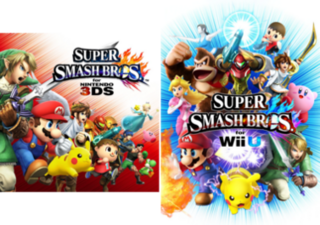
Super Smash Bros. for Nintendo 3DS and Super Smash Bros. for Wii U, both commonly referred together as Super Smash Bros. 4, are 2014 crossover platform fighter video games developed by Bandai Namco Studios and Sora Ltd. and published by Nintendo for the Nintendo 3DS and Wii U video game consoles. It is the fourth installment in the Super Smash Bros. series, succeeding Super Smash Bros. Brawl. The Nintendo 3DS version was released in Japan on September 13, 2014, and in North America, Europe, and Australia the following month. The Wii U version was released in North America, Europe, and Australia in November 2014 and in Japan the following month.
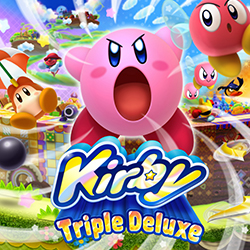
Kirby: Triple Deluxe is the thirteenth platform and tenth mainline installment of the Kirby video game series, developed by HAL Laboratory and published by Nintendo for the Nintendo 3DS. The game was released in Japan on January 11, 2014, in North America on May 2, 2014, in Europe on May 16, 2014, and in Australia on May 17, 2014. The game follows Kirby as he embarks on a journey through six worlds to rescue King Dedede from Taranza.
Amiibo is a toys-to-life platform by Nintendo, which was launched in November 2014. It consists of a wireless communications and storage protocol for connecting figurines to the Wii U, Nintendo 3DS, and Nintendo Switch video game consoles. These figurines are similar in form and functionality to that of the Skylanders, Disney Infinity and Lego Dimensions series of toys-to-life platforms. The Amiibo platform was preannounced to potentially accommodate any form of toy, specifically including general plans for future card games. Amiibo use near field communication (NFC) to interact with supported video game software, potentially allowing data to be transferred in and out of games and across multiple platforms.

Yoshi's Woolly World is a 2015 platform game developed by Good-Feel and published by Nintendo for the Wii U. The game is the seventh main entry in the Yoshi series of games, the first home console title in the series since 1997's Yoshi's Story, as well as the spiritual successor to 2010's Kirby's Epic Yarn. The game was released worldwide throughout 2015. A port for the Nintendo 3DS, known as Poochy & Yoshi's Woolly World, was released worldwide in early 2017. Both versions received generally favorable reviews, with reviewers praising the art style, gameplay, and innovation, but critiquing the easy difficulty.

Star Fox Zero is a 3D rail shooter video game developed by Nintendo and PlatinumGames for the Wii U. It is the sixth installment in the Star Fox series. Formally announced at E3 2015, the game was released in April 2016 to mixed critical reception, with the most polarizing aspect of the game being its control scheme. A standalone tower defense game, titled Star Fox Guard, was bundled with the game.
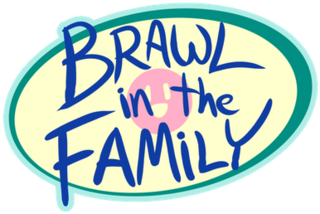
Brawl in the Family was a gag-a-day webcomic written and drawn by Matthew Taranto. The webcomic was inspired by the Super Smash Bros. series and features characters from various video game franchises, predominantly Nintendo series such as Kirby, Super Mario, Pokémon, F-Zero, and Metroid. The webcomic concluded on October 3, 2014, having produced a total of 600 comics.
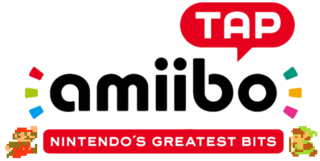
Amiibo Tap: Nintendo's Greatest Bits, known as Amiibo Touch & Play: Nintendo Classics Highlights in the PAL regions, was an application developed and published by Nintendo for the Wii U's Nintendo eShop in 2015. The application was used to play demos of 30 popular Nintendo Entertainment System and Super Nintendo Entertainment System video games by scanning, Amiibo figurines, Nintendo's toys-to-life series of products.
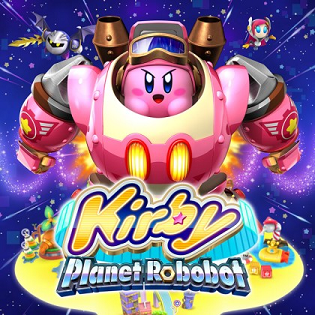
Kirby: Planet Robobot is a 2016 platform game developed by HAL Laboratory and published by Nintendo for the Nintendo 3DS. It is the eleventh mainline installment in the Kirby series and the spiritual sequel to Triple Deluxe. The story follows Kirby as he defends Planet Popstar from an alien corporation known as the Haltmann Works Company that wishes to mechanize the planet so that they can plunder its natural resources. New to the series in this game is Kirby's ability to utilize a mecha suit known as the Robobot Armor to solve puzzles and fight enemies.

Kirby Star Allies is a 2018 platform video game developed by HAL Laboratory and published by Nintendo for the Nintendo Switch. It is the twelfth mainline installment in the Kirby series, the player controls Kirby in his quest to prevent a priest named Hyness from reviving a dark force to destroy the universe. Kirby must complete each level by jumping, inhaling enemies, and using his array of abilities to progress.
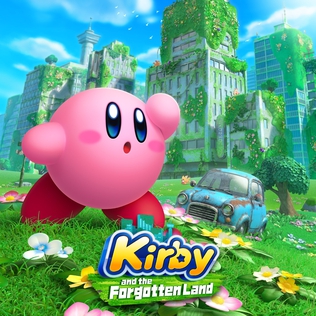
Kirby and the Forgotten Land is a 2022 platform video game developed by HAL Laboratory and published by Nintendo for the Nintendo Switch. It is the thirteenth mainline installment in the Kirby series, as well as the first game in the series in full 3D, excluding spin-offs. The player controls Kirby in an adventure through the titular forgotten land called the New World to rescue Waddle Dees kidnapped by the ferocious Beast Pack. To complete each stage to save the Waddle Dees, Kirby can use a wide range of copy abilities to help battle enemies and progress.

















